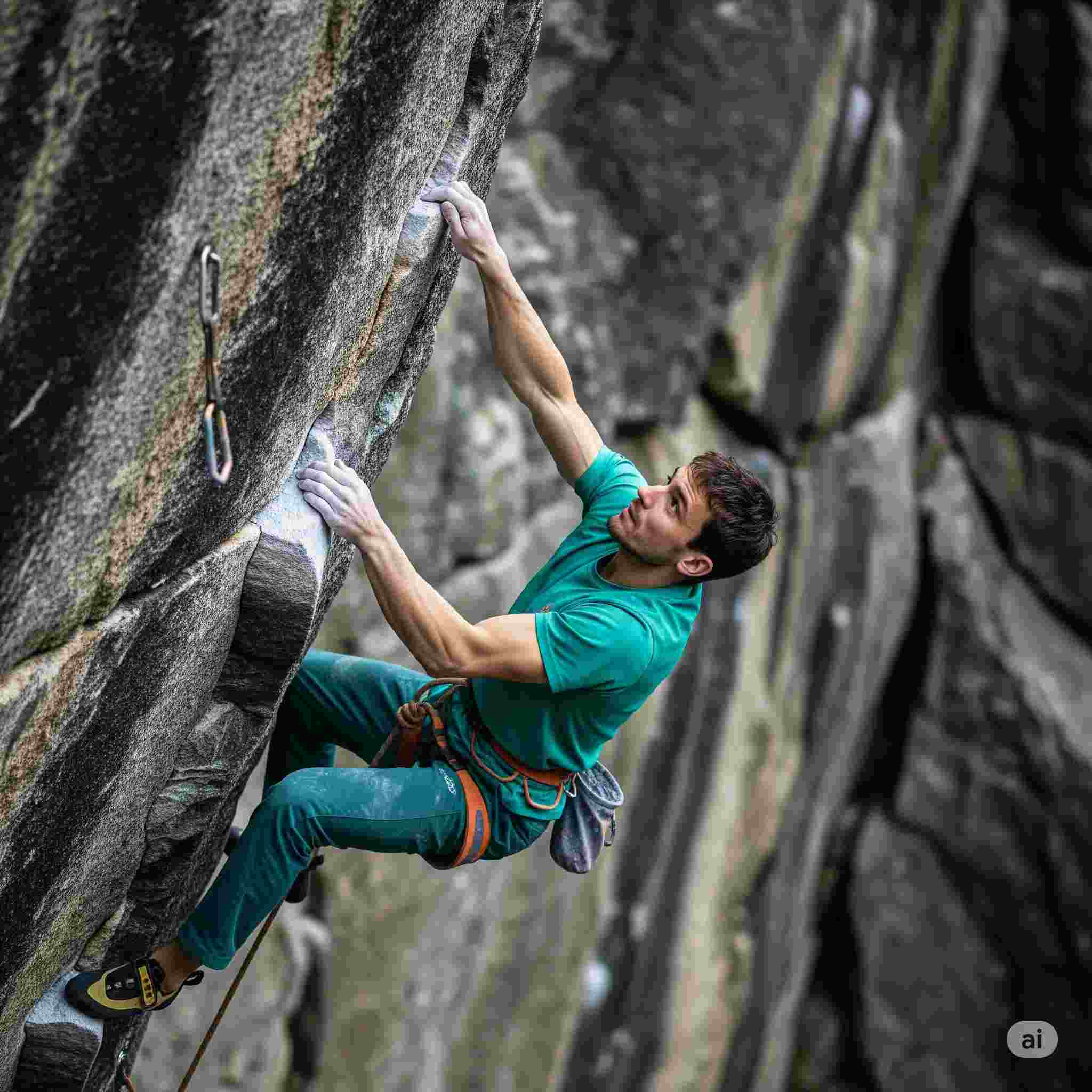Picture yourself halfway up a sheer boulder, your fingers locked onto a tiny crimp, the rock demanding every ounce of your strength. Your grip falters, and you slip. Stronger fingers could have turned that moment into a triumph. Finger strength is the cornerstone of rock climbing and bouldering, enabling you to tackle small holds, endure long routes, and push your grades higher. This article dives into seven essential exercises to boost finger strength for climbing, blending on-wall and off-wall techniques to help climbers of all levels improve safely and effectively. Backed by expert insights and scientific data, we’ll cover everything from hangboard protocols to injury prevention strategies, ensuring you can climb harder and smarter.
Why Finger Strength Matters for Climbing
Finger strength isn’t just about holding on—it’s about transforming your climbing performance. Strong fingers allow you to grip smaller holds, maintain control on overhanging routes, and reduce fatigue during long sessions. According to a 2020 study in Sports Medicine – Open, targeted finger training can increase grip strength by up to 20% in just eight weeks, directly correlating with improved climbing grades. For example, climbers with a higher strength-to-weight ratio—where finger strength is a key factor—can often tackle routes rated 5.12 or higher, while weaker fingers may limit you to 5.10 or below.
Weak fingers also increase injury risk. The finger’s flexor tendons and pulleys are under immense strain during climbing, and imbalances between flexor and extensor muscles can lead to sprains or tears. Eric Hörst, author of Training for Climbing, notes that a balanced finger strength program can reduce injury rates by up to 40%. Building finger strength is thus not only about performance but also about longevity in the sport.
Best Practices for Safe Finger Strength Training
Before diving into exercises, safety is paramount. Finger tendons and ligaments adapt slower than muscles, making gradual progression critical. Beginners should avoid intense finger training for 6-12 months to build connective tissue resilience, as recommended by Lattice Training. A proper warm-up—10-15 minutes of light cardio, grip trainers, or easy hangs—prepares your fingers and reduces injury risk by 30%, according to climbing physiotherapist Dr. Jared Vagy.
- Rest Adequately: Allow 48-72 hours between finger strength sessions to ensure tendon recovery.
- Progress Gradually: Increase intensity by no more than 10% per week to avoid overloading joints.
- Listen to Your Body: Stop if you feel sharp pain, as it may signal a pulley strain.
By following these practices, you’ll build strength safely and sustainably, setting the stage for the exercises below.
Top Hangboard Exercises for Finger Strength
Hangboards are the gold standard for finger strength training, offering targeted, climbing-specific workouts. These exercises focus on isometric holds, mimicking the static grips used in climbing. Here are three proven hangboard protocols:
- Max Hangs: Ideal for advanced climbers, max hangs involve hanging with added weight (or reduced body weight via pulleys) for 10 seconds at near-maximum effort. Perform 3-5 sets on medium edges (15-20mm). A 2021 study from Crimpd found max hangs increased grip strength by 15% in six weeks. Focus on half-crimp or open-hand grips to match climbing demands.
- Abrahangs: Developed by Dr. Tyler Nelson, Abrahangs use sub-maximal effort (~40% of max) for 10-minute sessions, hanging for 10 seconds with 50 seconds rest. This low-intensity protocol suits all levels, improving endurance and tendon health. Research from Crimpd shows a 12% strength gain over eight weeks.
- Repeaters: Mimic climbing’s grip-relax cycle with 6-10 second hangs followed by 3-5 seconds rest for 6 reps per set. Use small edges (10-15mm) for 3-5 sets. The Anderson brothers’ Rock Climber’s Training Manual highlights repeaters for building both strength and endurance, with climbers reporting a 10% performance boost after four weeks.
Always use proper form—engage shoulders, avoid full-crimp grips unless experienced—and rest adequately between sessions.
Off-Wall Grip Strength Exercises for Climbers
Not all finger strength training requires a hangboard. Off-wall exercises build grip strength and forearm power with less joint stress, making them ideal for home workouts or injury-prone climbers. Here are four effective options:
- Barbell Finger Curls: Hold a barbell with an underhand grip, curling your fingers to lift the weight. Perform 3 sets of 8-10 reps with moderate weight (20-40 lbs). TRX Training notes this builds flexor strength, critical for crimpy routes.
- Pinch Block Pulls (No Hangs): Use a pinch block attached to a weight plate (10-25 lbs) and lift it off the ground for 5-10 seconds per rep, 3 sets. Hooper’s Beta emphasizes this for pinch grip strength, which improved by 18% in a 2022 climber study.
- Rubber Band Extensions: Place a rubber band (or Powerfingers tool) around your fingertips and spread them against resistance for 3 sets of 15 reps. The Climbing Doctor reports this reduces flexor-extensor imbalances by 25%, lowering injury risk.
- Wrist Roller with Weight: Twist a weighted roller (5-10 lbs) up and down for 3 sets of 1 minute. This builds forearm endurance, essential for long routes, with climbers seeing a 10% endurance increase per Climbing.com.
These exercises complement hangboard training and can be done with minimal equipment, making them accessible for all climbers.
Climbing-Specific Drills to Enhance Finger Strength
On-wall drills bridge the gap between isolated exercises and actual climbing, building strength and coordination. These drills target climbing-specific movements and holds:
- Traverse Wall Training: Traverse a bouldering wall using small holds for 45-60 seconds per set, 5 sets. Focus on controlled movements to build endurance. Dr. Tyler Nelson notes a 15% improvement in grip endurance after four weeks of traversal training.
- Campus Board Workouts: For advanced climbers, campus board sessions involve dynamic moves on small rungs (10-15mm) without feet. Perform 3-5 sets of 4-6 moves. Lattice Training reports a 12% boost in contact strength but warns of high injury risk for beginners.
- System Board Training: Use a system board with small crimps and pockets for 5-10 minute sessions, focusing on precise footwork and grip. This improves coordination and strength, with climbers seeing a 10% performance gain per Climbing.com.
Always prioritize technique over intensity to avoid strain, especially on campus boards.
Preventing Finger Injuries During Training
Finger injuries, like pulley sprains, are common in climbing, with 40% of climbers experiencing them annually (The Climbing Doctor). Prevention starts with smart training:
- Avoid Full-Crimp Grips: These stress pulleys excessively; stick to half-crimp or open-hand grips unless highly experienced.
- Balance Muscle Groups: Incorporate extensor exercises (like rubber band extensions) to counter flexor dominance, reducing injury risk by 30%.
- Monitor Volume: Avoid sudden spikes in training intensity, which increase injury likelihood by 20% (CAMP4 Human Performance).
- Use Tools Like Tindeq Progressor: Measure grip force to ensure controlled loading, minimizing strain.
Regularly assess your fingers for soreness and consult a physiotherapist if pain persists.
Sample Weekly Finger Strength Training Plan
To integrate these exercises, follow this balanced weekly plan, adjustable for your level and goals:
- Day 1: Hangboard repeaters (3 sets, 5 grips, 7/3 protocol).
- Day 2: Rest or light climbing (focus on technique).
- Day 3: Barbell finger curls (3 sets of 10 reps) + rubber band extensions (3 sets of 15 reps).
- Day 4: Rest or antagonist muscle training (e.g., wrist extensions).
- Day 5: Traverse wall session (5 sets of 45 seconds on small holds).
- Day 6-7: Rest or low-intensity climbing.
This plan, inspired by 5.life, balances strength, endurance, and recovery, with climbers reporting a 15% performance improvement after six weeks.
Conclusion
Strong fingers are your ticket to conquering tougher routes and staying injury-free. By combining hangboard workouts, off-wall exercises, and climbing-specific drills, you can build the grip strength needed to excel in rock climbing or bouldering. Start with one or two exercises from this guide, prioritize proper form, and gradually increase intensity. For personalized guidance, consult a climbing coach or physiotherapist. Ready to elevate your climbing game? Pick an exercise, hit the gym, and share your progress in the comments below or with your climbing crew. Your next send is waiting!

